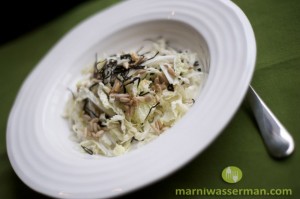Become a Sea Veggie Superstar!
Sea vegetables are just what they sound like: greens that grow in the sea. These healthy vegetables include nori (what your sushi is wrapped in), wakame (what is in your miso soup), arame (often in your seaweed salad), dulse, kombu, kelp and hijiki. Sea vegetables also include varieties of seaweed hidden in prepared foods such as ice cream, baked goods, jelly, salad dressings, chocolate milk and toothpaste.
Grown in the depths of the sea, these green wonders are full of vitamins and minerals essential to human health and nutritional balance. Minerals make up seven to thirty-eight percent of the dry weight of these superfoods; the most significant minerals found in sea greens are calcium, iodine, phosphorous, sodium and iron, but they are also rich in other nutrients like protein and vitamins A, B, C and E.
Sea vegetables can help with everything from reducing blood cholesterol, removing metallic and radioactive elements from the body, and preventing goiters. Seaweed also has antibiotic properties, may counteract obesity, could improve digestion and nerve transmission, and strengthens bones and teeth. To top it off, sea veggies have been researched as a beauty aid for their skin-improving and anti-aging properties.
Sea vegetables and thyroid health
Seaweed got a boost of recognition earlier this year, after the devastating earthquake in Japan, thanks to the presence of the mineral iodine in these vegetables. Radiation fears spread to the west coasts of Canada and the United States when the quake and subsequent tsunami caused serious damage to a nuclear reactor; iodine pills are great way to protect against some of the effects of radiation.
Iodine is also a key mineral for thyroid health, which is the role it’s more likely to play in the average person’s diet. Our bodies need iodine for thyroid hormone production, which helps keep our metabolism working properly. That’s why weight gain is a symptom of hypothyroidism and weight loss is a symptom of hyperthyroidism — our metabolism, and therefore our weight, is affected when these hormones are out of whack.
People used to get their RDA of iodine — 150mcg for most adults — largely from iodized salt, but as more people reduce the sodium in their diets, deficiencies could occur. That’s one important reason why seaweed is a great dietary addition — it’s one of the best food sources of iodine. Regularly including a variety of sea vegetables in your diet can help keep your thyroid working properly.
How do you use sea veggies?
Sea vegetables are extremely versatile — they can be used in a number of recipes and incorporated into numerous styles of cuisine. They compliment or accent many dishes, from soups and salads to even desserts.
Give sea vegetables a go in your diet with this recipe using seaweed in perhaps its most familiar form — wrapping of nori rolls.
Napa Cabbage Salad
Makes 6-8 servings
Ingredients:
1 whole napa cabbage, washed and sliced into shreds
1/4 cup of soaked arame
1 cup shelled cooked edamame (optional)
1/3 cup toasted sunflower seeds
2 Tablespoons sesame seeds or poppy seeds
Dressing:
1/3 cups olive oil
¼ cup brown rice syrup
¼ cup brown rice vinegar
1 tablespoon tamari
1 tablespoon sesame oil
1 small or medium onion, grated
1-2 cloves garlic, minced
Instructions:
- Soak arame in water for 20 minutes.
- Place the cabbage in a large salad bowl with the edamame. Add in soaked arame. In a smaller bowl, combine all the ingredients for the dressing and mix well.
- Pour over the salad mixture in the bowl, then top with the nuts and seeds and toss.
- Serve immediately.
Originally posted on Chatelaine.



